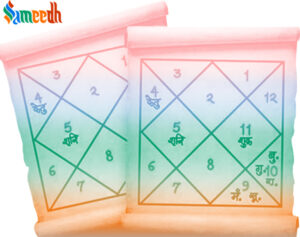A “kundali” typically refers to a birth chart or horoscope in Hindu astrology. It’s a map of the positions of the celestial bodies at the time of an individual’s birth. Kundalis are used to gain insight into a person’s character, life events, and potential future based on the positions of the planets, stars, and other astrological factors.

In Hinduism, a “kundali” (also spelled as “kundli” or “natal chart”) is a vital component of astrology. It’s essentially a birth chart that represents the positions of celestial bodies at the time of an individual’s birth. Kundali is derived from the Sanskrit word “kundal” which means “coil” or “circle.”
The kundali is believed to capture the cosmic energy pattern existing at the moment of a person’s birth. It’s divided into twelve sections known as houses, each representing different aspects of life such as career, family, health, relationships, etc. The planets, including the Sun and the Moon, as well as the twelve zodiac signs, are placed within these houses in the chart.
Kundali reading is typically performed by astrologers, who are individuals with expertise in astrology and the interpretation of birth charts. These astrologers may have undergone formal training in astrology or have acquired knowledge through traditional teachings, books, or personal experience.
To create a kundali, also known as a birth chart or horoscope, several pieces of information are required. Here’s what’s typically needed:
- Date of Birth: The exact date of birth of the individual for whom the kundali is being prepared is crucial. This includes the day, month, and year of birth.
- Time of Birth: The precise time of birth is essential for accurate calculations in astrology. This includes the hour and minute of birth, ideally noted in local time.
- Place of Birth: The location where the individual was born, including the city or town, state or province, and country, is needed to calculate the positions of celestial bodies accurately.
Once these details are available, an astrologer or someone with knowledge of astrology can use specialized software, online tools, or manual calculations to generate the kundali.
In Hindu astrology, kundali is used for various purposes, including:
- Personal Insight: It provides insights into an individual’s personality, strengths, weaknesses, and potential life events based on the positions of planets and their interactions.
- Future Prediction: Astrologers use kundali to predict future events and trends in an individual’s life, including career opportunities, relationships, health issues, and other significant life changes.
- Compatibility: Kundali matching (Kundali Milan) is commonly practiced before marriages in Hindu culture to assess the compatibility between the prospective bride and groom. The alignment of planets in both charts is compared to determine the harmony and longevity of the marital relationship.
- Remedies: Astrologers may suggest remedies or solutions to mitigate the effects of unfavorable planetary positions or doshas (flaws) in the kundali, such as wearing gemstones, performing rituals, or adopting specific lifestyle changes.
While kundali and astrology play significant roles in Hindu culture, it’s important to note that interpretations and beliefs surrounding them can vary widely among practitioners and communities.
In Hinduism, the individual who reads and interprets kundalis is commonly referred to as an “astrologer” or “jyotish.” Jyotish is a Sanskrit term that translates to “light” or “knowledge” and is often used to denote the practice of astrology in Hindu culture.
It’s important to note that while astrology and kundali reading are deeply ingrained in Hindu culture, not all individuals within the Hindu community may subscribe to or consult astrologers. Beliefs and practices regarding astrology can vary widely among individuals and communities.
